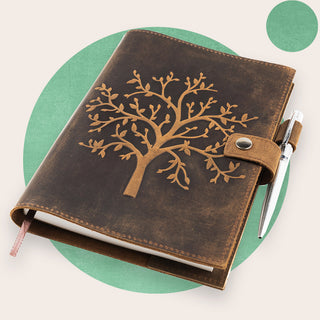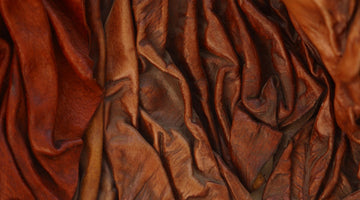Are you looking to get started with art journaling? Do you find language sometimes ineffective at truly capturing your essence or creative spirit? Do you want to bypass this aspect of expression entirely, opting instead to use the visual arts for creative means?
Then you have found yourself in the right place, for today we will be exploring why you might take up art journaling and how to get started.
Why Start an Art Journal?
Since there are theoretically no rules when starting an art journal, you really can do whatever you like. Art journals are for experimentation of the highest degree! Here are some more reasons you might want to start your own art journal.
1. Working Out Thoughts & Feelings
If you are prone to experiencing the odd bad day from time to time and want an effective way to process it without doing damage to your psyche, then perhaps you would find art journal pages an apt place to do so.
In your own journaling habit, you can use whatever art supplies or mixed media you like to really capture as wholly as possible how you felt and what you are going to do about it!
2. Dreaming & Planning
Perhaps you are the kind of person with big ideas and ambitions to change the world - in which case, an art journal is the perfect place to bring these things to life before bringing them to life.
Through the use of art journal supplies and mixed media art journaling, you can bring about something that more closely resembles the vision of the thing that you have in your head, enhancing your creative process for the better.
This really can be about anything, so gape your imagination and let it run wild.
3. Creativity
More than anything, this is simply a great place to exercise your creative abilities and imagination, no matter what kind of art materials you use to do it.
All people are creators of something or other, born with a natural creative instinct that lives on to varying degrees in all of us.
So, regardless of the art journaling materials that you are inclined toward using, your artistry is completely valid and the use of an art journal can reawaken a long-dormant urge to create.

4. Personal & Spiritual Growth
Those already invested in spiritual journaling will already be privy to the various benefits that journaling can have for spiritual practice in this way. No matter whether you use watercolor paper or lined paper, you can easily supplant your own spiritual visions and epiphanies onto any sort of surface and better explore your own spiritual leanings.
It is all well and good engaging in spirituality with words, but sometimes the power of an art journaling journey goes beyond those words, in which case you would be best advised to side-step language in favor of some crayons (or such like).
5. Play
Arguably most important of all when engaging with art journaling - and often the sign of the best art journal - is the idea that adults should play and have fun from time to time. Plenty of research - both academic and otherwise - has been done in this field, showing the art and magic of play.
For adults, this is something often lost to the reality of adult life, but it doesn't have to be this way. You can, instead, use a visual diary as your next art journal step to re-engage with the playful part of yourself, bypassing sense and logic in favor of something else entirely.
How to Get Started with Your Own Art Journal
So, by now you should surely be convinced of the pleasures of an art journal. Now, let's look at how you can go about getting started.
1. Gathering Supplies
The first step is to gather the supplies you might be using. If you already have a set style of art, why not try pushing yourself out of your comfort zone and using a supply that you might not otherwise use?
For example, if you are more inclined toward maximalist multi-media art, why not try doing as much as you can with as little as possible like, say, indenting art into paper with something that isn't going to leave a mark other than the indentation?
2. Finding a Space
Now you have your supplies, you can begin to think about stockpiling them all in one place. This place doesn't have to be anything particularly special - it could just be a place in your kitchen where you feel most at ease.
This, after all, is the most important thing - that you should feel at ease - unless, of course, you are looking to really push your psyche to its outer limits in your journaling practice.

3. Background
If you are struggling to know where to start, then a great place to begin is by creating a background upon which to impress your artistic vision.
Of course, as with everything in this journal, there is no right or wrong way to go about it, so you really can go crazy with it. You might prefer a more traditional white background as in a canvas, though equally you might like it to get a bit more textured, in which case you can always stick whatever detritus you find in your garden to the page.
4. Layers
Now, you can really begin to get going, adding more and more layers until, someday, you deem your creation finished and/or ready for public consumption. Remember, though, the latter route of public consumption is not always necessary, despite what artists in Wes Anderson's The French Dispatch might have you believe.
Adding layers to a piece - i.e. adding to a piece of art and then stepping back and leaving it for a bit (either to dry or otherwise simply to sit) - will give it more of a 3-dimensional texture, making it appear as though it is popping out from the page.
5. Drying
Now, once you deem your creation to be finished, you can go ahead and leave it to properly dry.
Those who are new to the art journaling game are prone to struggling with pages that stick together, a phenomenon that happens when an art journal is closed sooner than is needed for the contents to dry.
Do yourself and your creations a favor and allow them a good while to dry before going to close the art journal and putting it back on the shelf. You can't go wrong with leaving your own journal open for at least 24 hours in a room without a breeze that might otherwise flick the pages and disrupt the natural order of this drying process.
Final Words
So, there you have it! Hopefully, you are now feeling ready and able to get started!
FAQs Art Journaling
WHAT DO YOU DO IN AN ART JOURNAL?
An art journal is a space for creation in its purest form, so what you do in an art journal, though it will likely take the form of some sort of artistic expression, is at the end of the day entirely up to you. In this way - and if you are so inclined - your own form of artistic expression might be tax returns and pie charts, in which case you would be more than welcome to go on mining this dim enterprise.
WHAT KIND OF ART JOURNAL SHOULD YOU USE FOR ART JOURNALING?
There is no specific type of journal that you should use for art journaling - rather, you should pick one that most speaks to you and your individual artistic vision. Commonly, you would go for a journal that has blank pages made from fairly thick material if, say, you were looking to do some painting, but you can equally throw out the rule book and draw on lined or even graph paper if you feel so inclined.
WHAT IS AN ART JOURNAL?
An art journal is a type of journal that encourages artistic expression. Of course, art is an umbrella term that encompasses any form of creative expression - though, there are many that even debate such a definition. Thus, it would be better to emphasize that an art journal is primarily focused on the visual arts, even if there will be interjections and multimedia conversations between visual and written languages on the page from time to time.
WHAT IS ART JOURNALING?
Art journaling is a form of journaling that prizes above all else the expression of one's thoughts and feelings through the mode of artistic expression inherent to the visual arts.
WHAT MATERIALS ARE USED IN ART JOURNALING?
You can use any materials whatsoever in art journaling and that's precisely the point. You should use materials that feel right to you, even if you are attempting to stray a little outside your comfort zone. If you are not at all used to visual artistic expression, then just go with what feels right. If, though, this is something you are well-versed in, then try using a different medium or material to test yourself.
WHAT ARE THE BEST ART JOURNALS?
The best art journals are the ones that are as vivid an expression of the owner as possible. For this, it must be an honest and fair portrayal of the person and, thus, should capture something of their spirit. Most importantly, just stay true to yourself and your desires and you will have one of the best art journals around!



